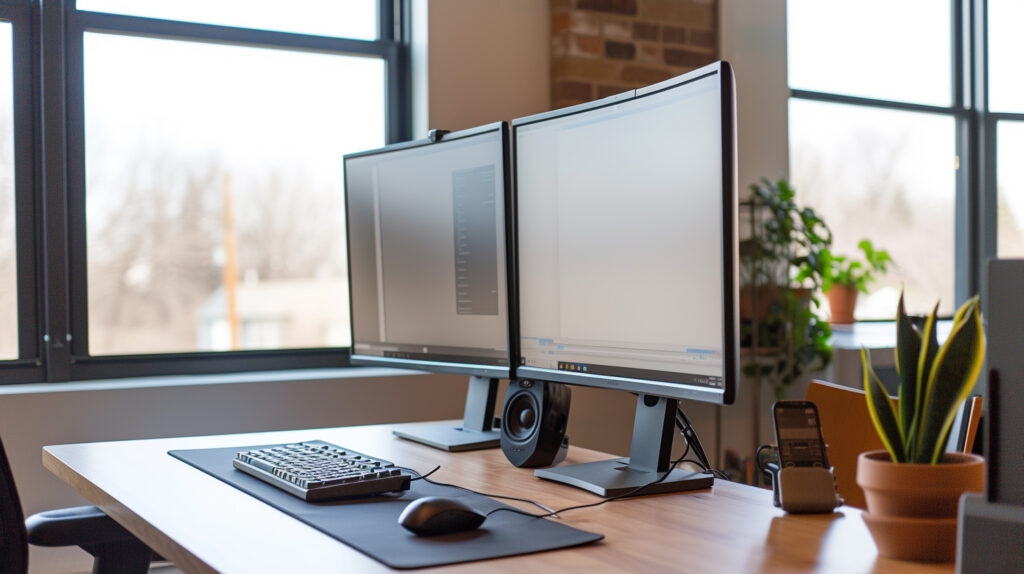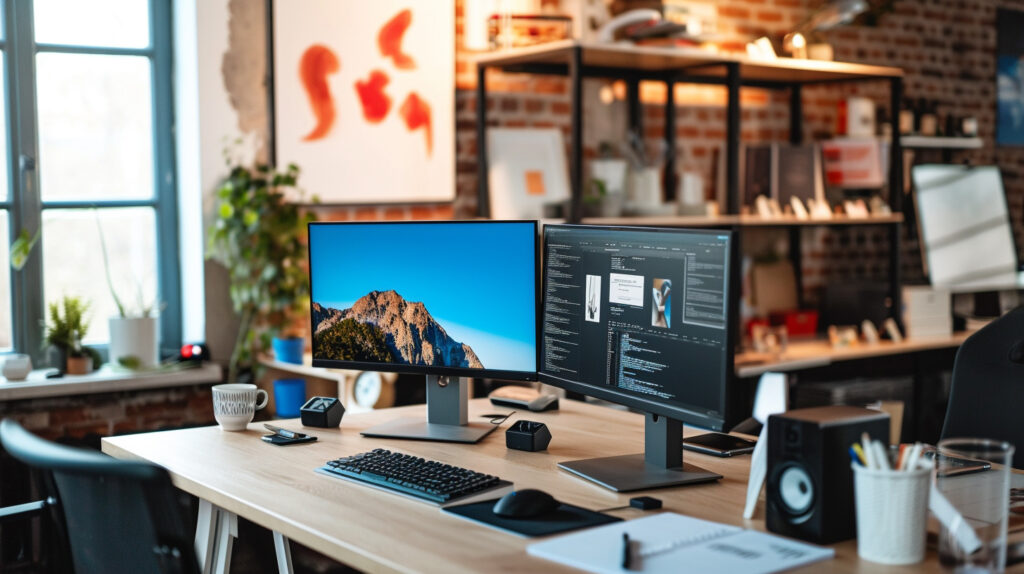How to Set Up Dual Display


Extending your digital workspace across two monitors can make tasks more manageable and visually accessible. This expansion of screen real estate allows for more efficient workflow management, with the ability to have reference materials on one screen while working on another. It can also enhance visual experiences for gamers and movie enthusiasts.

At its core, dual display technology enables a single computer to output its video signal to two separate monitors, effectively doubling the visual workspace available to the user. This technology hinges on the capability of the computer's graphics processing unit (GPU) to support multiple outputs, a feature now standard in most modern computers.
The hardware required for a dual display setup is straightforward but crucial for a successful configuration. Firstly, the graphics card or GPU must have multiple output ports - common types include HDMI, DisplayPort, DVI, and VGA. The choice of port largely depends on the GPU's available outputs and the input options of the monitors being used. In some cases, adapters may be necessary to connect the monitors to the graphics card, especially when dealing with different port types between the GPU and monitor.
Cables are the conduits that bridge the GPU with the monitors, and selecting the right cable is pivotal. HDMI and DisplayPort cables are prevalent in today's setups, offering high bandwidth to support high-resolution displays and, in the case of HDMI, audio transmission as well. DVI and VGA cables, while older standards, are still in use, especially in environments where legacy hardware is present.

This phase is crucial to ensure that your computer system is not only compatible but also optimized for an additional monitor.
Before diving into the world of multiple monitors, it's essential to verify that your computer can support a dual display setup. This involves a quick examination of your computer’s graphics card and available ports. Most modern computers are equipped with graphics cards that can handle multiple displays. To check, you can look up your computer or graphics card specifications online or consult the device's manual.
Understanding the types of ports available on your computer is the next step. Common video output ports include HDMI, DisplayPort, VGA, and DVI. HDMI and DisplayPort are prevalent in newer systems, offering high-quality audio and video transmission. VGA and DVI, while older, are still found in many systems. Depending on the connections available, you might need an adapter to connect your second monitor, especially if the monitor's input doesn't match the computer's output.
Selecting the right monitors for your dual display setup is about balancing functionality with personal preference. When considering size, resolution, and refresh rate, aim for monitors that complement each other to create a cohesive and seamless experience. The ideal setup would involve two identical monitors, ensuring uniform color quality, brightness, and an uninterrupted visual flow between screens.
However, using two different monitors is also a viable option, especially if they serve distinct purposes. For instance, a graphic designer might pair a high-resolution monitor for design work with a standard monitor for emails and administrative tasks. If opting for two different monitors, try to match their resolution and aspect ratios as closely as possible to minimize discrepancies in display quality.

Setting up dual displays begins with ensuring you have the correct cables to connect your monitors to your computer. Common connections include HDMI, DisplayPort, DVI, or VGA. It's essential to check your computer's and monitors' ports to purchase the correct cables or adapters.
In Windows 10 and 11, configuring dual displays is straightforward:
For Mac users, setting up dual displays involves:
Linux distributions vary, but most offer an intuitive way to set up dual displays:
Achieving optimal color accuracy, brightness, and contrast across dual displays is crucial for a harmonious viewing experience. Users should initiate the calibration process by accessing the display settings on their computer. Many operating systems offer calibration tools to guide users through adjusting gamma settings, color balance, and contrast ratios. For professional tasks that demand high color fidelity, investing in a hardware colorimeter could be beneficial, ensuring that colors are reproduced accurately on both screens. Additionally, aligning dual screens for a seamless transition involves not just the physical placement of the monitors to minimize gaps or differences in height but also tweaking the display settings to ensure cursor movement and window transitions feel natural and intuitive.
For those looking to enhance productivity, organizing windows and applications effectively across dual monitors can significantly impact workflow efficiency. Utilizing third-party window management tools can offer greater control, allowing users to snap windows to predetermined sections of the screen or seamlessly move applications between monitors. When it comes to gaming and entertainment, choosing between extended and mirrored display modes becomes pivotal. Extended mode is ideal for immersive gaming experiences or for extending a workstation, while mirrored mode suits presentations or sharing content across screens. Gamers will also benefit from ensuring their primary display is set to the monitor with the highest refresh rate and resolution to optimize performance.
Users may encounter challenges such as mismatched resolutions, where one monitor displays sharper or more vibrant images than the other. This can often be rectified in the display settings by ensuring both monitors are set to their native resolutions. Connectivity issues may arise from faulty cables or incorrect port usage; switching to a different cable or port usually resolves these problems. Additionally, if one of the displays is not detected, checking the screen's input source or restarting the computer can often re-establish the connection.
Venturing into more complex setups, such as triple or quadruple displays, opens a new realm of productivity and immersive entertainment possibilities. These configurations require careful consideration of the graphics hardware capabilities, as well as desk space and power requirements. For gaming, ensuring that the GPU can support high resolutions across multiple displays is crucial for a smooth experience. Professionals in graphics work or trading can benefit from multiple displays by having extensive visual real estate, allowing for constant monitoring of live feeds, extensive timelines, or detailed editing work.

Here's a detailed look into some frequently asked questions to enhance your dual display experience.
To display different things on two monitors, ensure your computer recognizes both displays. In Windows, navigate to Settings > System > Display, select "Extend these displays" under Multiple Displays. This allows you to drag and drop windows between monitors, showing different content on each. macOS users can achieve this by going to System Preferences > Displays, then arranging their screens accordingly.
Creating a split screen on a single monitor involves resizing and positioning windows side by side. On Windows, you can snap windows to either side of the screen by dragging them to the screen's edge or using the Windows Key + Left/Right Arrow. macOS offers a similar feature called Split View, which can be activated by holding down the full-screen button in a window's upper-left corner and choosing which side of the screen it should occupy.
To connect a set of two monitors to two separate computers while maintaining a dual monitor setup for each requires a KVM (Keyboard, Video, Mouse) switch that supports dual monitor setups. This device allows you to control both computers with one keyboard, mouse, and two monitors, switching between systems as needed.
If your dual monitor setup isn't working, start by checking all physical connections, ensuring cables are securely plugged in and monitors are powered on. Next, verify that your computer's display settings are correctly configured to recognize both monitors. Updating graphics drivers or resetting the display settings may also resolve the issue. If problems persist, consider swapping cables or monitors to rule out hardware faults.
To split display between Monitor 1 and 2 in Windows, go to Settings > System > Display. Here, ensure that the "Extend these displays" option is selected under Multiple Displays. This configuration allows you to move applications and windows across monitors freely, effectively splitting your workspace across two screens.